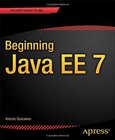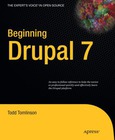Beginning Java 7

Book Details:
| Publisher: | Apress |
| Series: | Apress , Beginning |
| Author: | Geoff Friesen |
| Edition: | 1 |
| ISBN-10: | 1430239093 |
| ISBN-13: | 9781430239093 |
| Pages: | 920 |
| Published: | Nov 23 2011 |
| Posted: | Nov 19 2014 |
| Language: | English |
| Book format: | |
| Book size: | 8.38 MB |
Book Description:
Beginning Java 7 guides you through version 7 of the Java language and a wide assortment of platform APIs. New Java 7 language features that are discussed include switch-on-string and try-with-resources. APIs that are discussed include Threading, the Collections Framework, the Concurrency Utilities, Swing, Java 2D, networking, JDBC, SAX, DOM, StAX, XPath, JAX-WS, and SAAJ. This book also presents an introduction to Android app development so that you can apply some of its knowledge to the exciting world of Android app development. This book presents the following table of contents: Chapter 1 introduces you to Java and begins to cover the Java language by focusing on fundamental concepts such as comments, identifiers, variables, expressions, and statements. Chapter 2 continues to explore this language by presenting all of its features for working with classes and objects. You learn about features related to class declaration and object creation, encapsulation, information hiding, inheritance, polymorphism, interfaces, and garbage collection. Chapter 3 focuses on the more advanced language features related to nested classes, packages, static imports, exceptions, assertions, annotations, generics, and enums. Additional chapters introduce you to the few features not covered in Chapters 1 through 3. Chapter 4 largely moves away from covering language features (although it does introduce class literals and strictfp) while focusing on language-oriented APIs. You learn about Math, StrictMath, Package, Primitive Type Wrapper Classes, Reference, Reflection, String, StringBuffer and StringBuilder, Threading, BigDecimal, and BigInteger in this chapter. Chapter 5 begins to explore Java's utility APIs by focusing largely on the Collections Framework. However, it also discusses legacy collection-oriented APIs and how to create your own collections. Chapter 6 continues to focus on utility APIs by presenting the concurrency utilities along with the Objects and Random classes. Chapter 7 moves you away from the command-line user interfaces that appear in previous chapters and toward graphical user interfaces. You first learn about the Abstract Window Toolkit foundation, and then explore the Java Foundation Classes in terms of Swing and Java 2D. Appendix C explores Accessibility and Drag and Drop. Chapter 8 explores filesystem-oriented I/O in terms of the File, RandomAccessFile, stream, and writer/reader classes. Chapter 9 introduces you to Java's network APIs (e.g., sockets). It also introduces you to the JDBC API for interacting with databases along with the Java DB database product. Chapter 10 dives into Java's XML support by first presenting an introduction to XML (including DTDs and schemas). It next explores the SAX, DOM, StAX, XPath, and XSLT APIs. It even briefly touches on the Validation API. While exploring XPath, you encounter namespace contexts, extension functions and function resolvers, and variables and variable resolvers. Chapter 11 introduces you to Java's support for SOAP-based and RESTful web services. As well as providing you with the basics of these web service categories, Chapter 11 presents some advanced topics, such as working with the SAAJ API to communicate with a SOAP-based web service without having to rely on JAX-WS. You will appreciate having learned about XML in Chapter 10 before diving into this chapter. Chapter 12 helps you put to use some of the knowledge you've gathered in previous chapters by showing you how to use Java to write an Android app's source code. This chapter introduces you to Android, discusses its architecture, shows you how to install necessary tools, and develops a simple app. Appendix A presents the solutions to the programming exercises that appear near the end of Chapters 1 through 12. Appendix B introduces you to Java's Scripting API along with Java 7's support for dynamically typed languages. Appendix C introduces you to additional APIs and architecture topics. Examples include Accessibility, classloaders, Console, Drag and Drop, Java Native Interface, and System Tray. Appendix D presents a gallery of significant applications that demonstrate various aspects of Java. Unfortunately, there are limits to how much knowledge can be crammed into a print book. For this reason, Appendixes A, B, C, and D are not included in this book's pages. Instead, these appendixes are freely distributed as PDF files. Appendixes A and B are bundled with the book's associated code file at the Apress website (http://www.apress.com/9781430239093). Appendixes C and D are bundled with their respective code files at my TutorTutor.ca website (http://tutortutor.ca/cgi-bin/makepage.cgi?/books/bj7). What youll learn The entire Java language, including Java 7-specific features such as switch on string, try-with-resources, final rethrow, multicatch, and SafeVarargs A huge assortment of Java 7 APIs, beginning with those APIs oriented toward the language itself, and including Java 7-specific APIs such as the Fork/Join Framework, Objects, and JLayer Various Java 7 tools, starting with the javac compiler and java application launcher How to create user interfaces, working with web services, and a whole lot more The basics of getting started with Android app development Who this book is forThis book targets the following groups of developers: Newcomers, skilled (to some degree) in other programming languages but with no previous exposure to Java Intermediate Java developers, skilled in the fundamentals of Java prior to Java 7 and looking to increase theirunderstanding of Java 7 language/API changes All developers looking beyond standard Java, who want to leverage Java 7 to create mobile apps via Android Even advanced Java developers may find a few items of interest. Table of Contents Getting Started with Java Discovering Classes and Objects Exploring Advanced Language Features Touring Language and Utility APIs Collecting Objects Touring Additional Utility APIs Creating and Enriching Graphical User Interfaces Interacting with Filesystems Interacting with Networks and Databases Parsing, Creating, and Transforming XML Documents Working with Web Services Java 7Meets Android
Download Link:
Related Books:
Beginning Java EE 7
Java Enterprise Edition (Java EE) continues to be one of the leading Java technologies and platforms. Beginning Java EE7 is the first tutorial book on Java EE7. Step by step and easy to follow, this book describes many of the Java EE7 specifications and reference implementations, and shows them in action using practical examples. This definitive book also uses the newest version of GlassFish to deploy and administer the code examples. Written by an expert member of the Java EE specification request and review board in the Java Community Process (JCP), this book contains the best information possible, from an experts perspective on enterprise Java technologies. What youll learn Get started with the latest version of the Java EE Platform. Explore...
The Well-Grounded Java Developer
Vital techniques of Java 7 and polyglot programming
Summary The Well-Grounded Java Developer offers a fresh and practical look at new Java 7 features, new JVM languages, and the array of supporting technologies you need for the next generation of Java-based software. About the Book The Well-Grounded Java Developer starts with thorough coverage of Java 7 features like try-with-resources and NIO.2. You'll then explore a cross-section of emerging JVM-based languages, including Groovy, Scala, and Clojure. You will find clear examples that are practical and that help you dig into dozens of valuable development techniques showcasing modern approaches to the dev process, concurrency, performance, and much more. Written for readers familiar with Java. No experience with Java 7 or new JVM languages required. ...
Beginning Drupal 7
This book focuses on the nontechnical user who is responsible for building, maintaining, and managing Drupal web sites. The book covers why you should consider using Drupal when building a new web site, what Drupal is, installing and configuring Drupal, creating and managing content, managing users, adding functionality to your web site through Drupal modules, and more advanced topics on using themes, panels, and views. By reading this book, you will: Understand why you should use Drupal and the power of the platform. Quickly build confidence in your ability to use Drupal. Gain the knowledge necessary to build, deploy, and manage web sites of moderate complexity on Drupal 7. What youll learn What Drupal is and why you should use it How to insta...
2007 - 2021 © eBooks-IT.org



